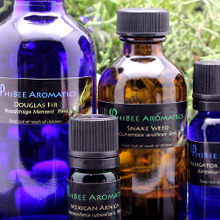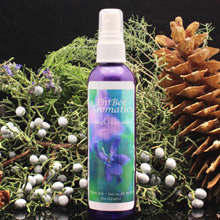MEXICAN ARNICA (Heterotheca subaxillaris) Essential Oil
Mexican Arnica, Healer of People and the Environment
By Clare Licher
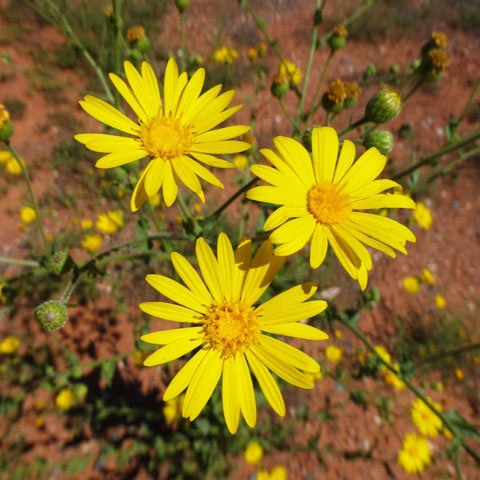 Every plant species has a unique purpose and gift that it
offers to the world. Like humans, some plants are known the
world over, while others live more quiet lives, only recognized
by a few passionate botanists. Some have been amenable to
domestication, while others refuse to be anything but forever
wild and free. Some travel well, and have become invasive
species in other lands, while others are so sensitive that they
can only survive in very specific habitats. What they all have in
common is an inherent intelligence and a symbiotic
relationship with other species in their environment. Plants
have been scientifically proven to communicate with and
respond to each other through root signaling. It has been
further hypothesized that they also communicate through
volatile organic compound signaling, and we are just beginning
to understand how far this reaches.
Every plant species has a unique purpose and gift that it
offers to the world. Like humans, some plants are known the
world over, while others live more quiet lives, only recognized
by a few passionate botanists. Some have been amenable to
domestication, while others refuse to be anything but forever
wild and free. Some travel well, and have become invasive
species in other lands, while others are so sensitive that they
can only survive in very specific habitats. What they all have in
common is an inherent intelligence and a symbiotic
relationship with other species in their environment. Plants
have been scientifically proven to communicate with and
respond to each other through root signaling. It has been
further hypothesized that they also communicate through
volatile organic compound signaling, and we are just beginning
to understand how far this reaches.
Mexican Arnica (Heterotheca subaxillaris) is a plant with a profound gift. If trees are considered the “lungs of the earth”, then Mexican Arnica is an aspect of the earth’s innate healing capacity. It offers us the opportunity to observe both the intelligence of nature and a correspondence between our own bodies and the ecosystem.
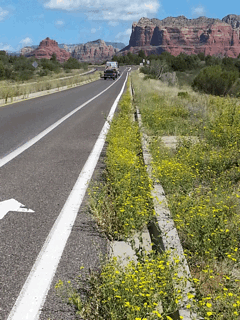 Mexican Arnica growing between the black top and gutter |
Growing in the southwestern United States, the original range of Heterotheca subaxillaris was from western Arizona to western Texas, between a 1,000- 5,000 feet (300- 1,500 meter) elevation. It is now found all the way to the east coast, and as far north as Delaware, with a closely related species, Heterotheca grandiflora, growing from New Mexico to the southern California coast. The plants grow on roadsides, in disturbed soils, on the edges of fields, and in junkyards. It would be easy to assume that this increase in range is due to cars speeding past, blowing seeds off of the plants and depositing them further down the road. While this may be an effective means of seed dispersal, the plant may also be responding to a deeper need that has been signaled in the environment.
Mexican Arnica is a native annual, that moves quickly through the environment, like a white blood cell, growing in places where the natural flow of water and movement have been damaged by human activity. It does not however, grow where there is natural excess water, such as the edges of ponds or streams. A road is a perfect reflection in the landscape of an injury and scar. The soil and rocks are disrupted, pulverized, rearranged, and then sealed with a hardened layer. Even with culverts, water no longer flows as freely and “run off” is created, which accumulates along the roadsides. This process is not unlike the swelling and congestion that accompany an acute injury. Mexican Arnica plants will insert themselves in the smallest of pavement cracks and grow to be quite large. Their strong root systems and stalks serve to break up black top, concrete and hardened soils, in what appears to be an attempt to restore a natural flow in the environment. Given enough time, I believe they would ultimately be successful.
The herb and essential oil used topically, inhibit inflammatory mediators, such as histamine, and act as a tissue sedative. Applied to an injury, the reduction of swelling, bruising, hardening and pain can be remarkable. In the traditional Mexican pharmacopeia, liniments and salves are used for sprains, dislocations and hyperextensions, and can also help resolve old injuries with lingering edema.
The tea of the whole dried plant has numerous medicinal benefits, and a long history of use for gas pain, diarrhea cramps and menstrual pain. Used topically, it is an excellent anti fungal and anti-septic wash to bathe skin rashes, ringworm and prickly heat.
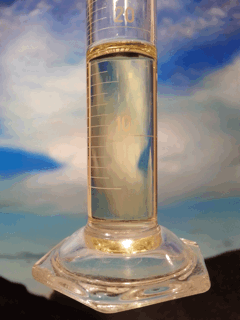 Mexican Arnica essential oil |
There is no historical tradition of essential oil distillation in the American Southwest, therefore, Mexican Arnica and many other Southwest essential oils are new to aromatherapy. These oils have not been the subject of clinical studies nor has much literature been written about them. We have to look to the longstanding ethno botanical uses of the plants, their chemical profiles (GC/MS reports), our own experiences and anecdotal accounts from others, to assess the safe and effective uses of these essential oils. Most of the time, the therapeutic benefits obtained through traditional uses of the plants overlap with the therapeutic benefits of the essential oils, but occasionally we will find a use that we have not seen a record of.
Mexican Arnica essential oil is also an outstanding remedy for blood blisters. Many years ago my husband, Max, was practicing archery with our daughters. His arm was to close when he let go of the string, and it grazed the inside of his forearm. He had three large friction burns from his wrist to his elbow. In the middle of his arm, an alarming looking blood blister the size of a nickel, and about ¼ inch (1/2 cm) high, formed immediately. This sent me running into the house to quickly put together a remedy for trauma.
I had been recently researching Mexican Arnica, and knew of its uses for acute trauma, bruising, swelling and inflammation, so the essential oil seemed like an obvious choice. I used Aloe Vera gelly as a base, added Mexican Arnica essential oil, and small amounts Peppermint and Lavender essential oils to also help cool the inflammation. We applied a layer to his arm, and I asked him to repeat this again in an hour or so. Soon after this he set off for Flagstaff, and to my dismay, I found his remedy still sitting on the table. Upon his return, 7 hours later, I asked to see his arm. There was no sign of the friction burn, and the raised blood blister had been reduced to a flat pink spot about ¼ inch (1/2 cm) in diameter.
Every Spring we begin scanning the environment for Mexican Arnica plants. They are easy to identify while driving in a car, not only because of their proximity to the road, but also as young plants their leaves grow straight up toward the sky. It is a fairly abundant plant in our region, but the challenge is to find it in places that are suitable for collection.
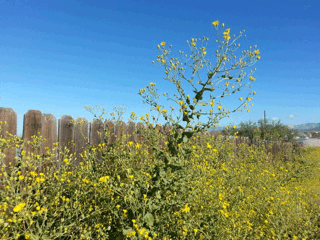 Mexican Arnica along Chris’ fence |
Three years ago I noticed some plants growing near a house in a nearby town. I had occasion to drive by there often, so I was able to watch their growth. There were quite a few more plants the second year, but we found enough others so I decided not to bother the residents. By the third year, the house was surrounded by magnificent specimens, some up to 7 feet (2 meters) tall. I could no longer control myself, and worked up the nerve to approach the homeowners. I was worried that they might feel intruded upon, but to the contrary and my happy surprise, they were very welcoming and users of plant medicines themselves. As we talked, a story unfolded that furthered my belief in the sensitivity and responsiveness of this plant. Three years ago, Chris, the man who lives there had injured his knuckles. Bacteria entered his blood stream, and the first symptom of infection was a profusion of blood blisters on his lower legs. No one could initially understand what was causing his symptoms, and as time went on, the blisters turned into sores that would not heal. He tried every antibiotic and natural remedy that offered any promise of relief. Eventually many of the sores that did heal turned into deep scar tissue. At the time of meeting him, the sores that had not healed would require surgery. The plants began proliferating on this property at around the time that he sustained his injury. The essential oil of Mexican Arnica would have been a perfect addition to his early treatment protocol, to address the blood blisters and fluid congestion in his legs. I strongly believe that the plants appeared in response to his acute need.
After hearing this story and being given permission, I collected some plants. It is important to collect this plant after it has gone at least partially to seed, so that seeds can be disbursed during the collection process. This will keep the seed bank high, and not interfere with the mission of the plants. The yield of essential oil from Mexican Arnica plants is extremely low, sometimes as low as .1%. It takes distilling it every day for weeks on end to build up even a few ounces of oil, but the results are worth the effort. We obtained enough essential oil from these plants to provide the family with a bottle of the pure oil, and a topical healing formula for Chris’ legs. He noticed improvement prior to having a surgery, but since then has had to cease all topical applications until it is known that his skin graft is successful. Currently he is awaiting the approval from his physician to begin using the formula again.
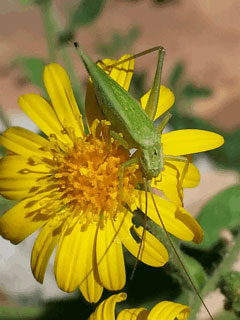 Mexican Arnica with Lace Wing |
Nature did not give Mexican Arnica such an important responsibility without also offering it a means of support. Green Lacewings, while not pollinators, are attracted to Mexican Arnica. Their presence and the uplifting singing sound that they make by rubbing their wings, is inseparable from the plant. The Lacewings eat mealy bugs, thrips, aphids and mites, and keep the plants free of infestations, even in the most stressful environments.
I will be forever grateful to Mexican Arnica for helping heal both my own and my daughter’s sprained ankles, my acutely injured toe, my children’s bruises, my dear friend’s migraine headaches from TBI, for countless other incidents that have not been included in this article, and for its service in healing the earth. I am indebted to it for opening my eyes to the deeper workings of the ecosystem.
Purchase Mexican Arnica Essential Oil here
Purchase Mexican Arnica Hydrosol here
References
Charles Eisenstein, (2013) The More Beautiful World Our Hearts Know Is Possible, P. 39- 40, North Atlantic Books, Berkeley, California
Hope Jahren, (2016) Lab Girl, P. 165- 167, Alfred A. Knopf, New York, Toronto
Charles Kane, (2006) Herbal Medicine of the American Southwest, P. 36- 37, Lincoln Town Press
Michael Moore, (1989) Medicinal Plants of the Desert and Canyon West, P. 21- 22, Museum of New Mexico Press, Santa Fe, New Mexico
Micheal Moore, (1992) Los Remedios P. 20, Red Crane Books, Santa Fe, New Mexico

